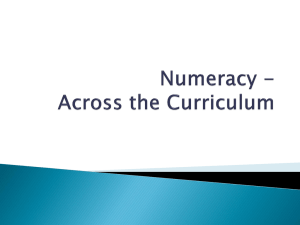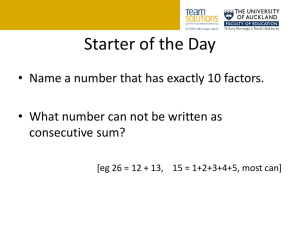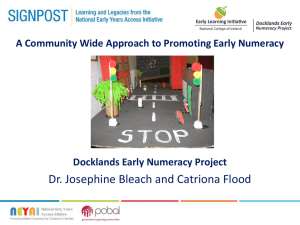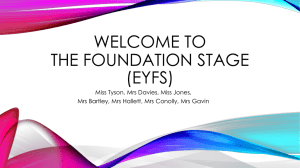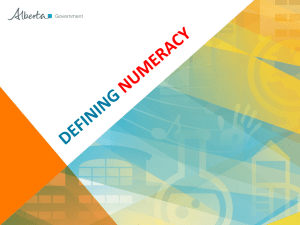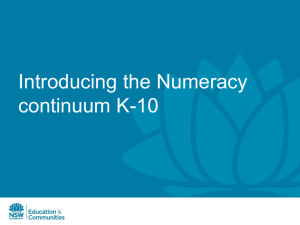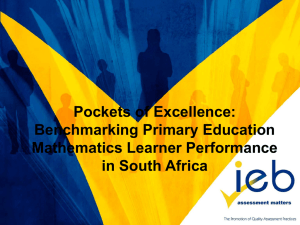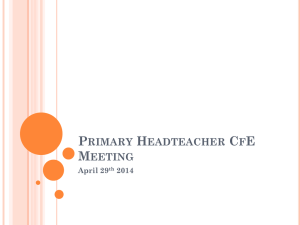Numeracy Training For Governors
advertisement
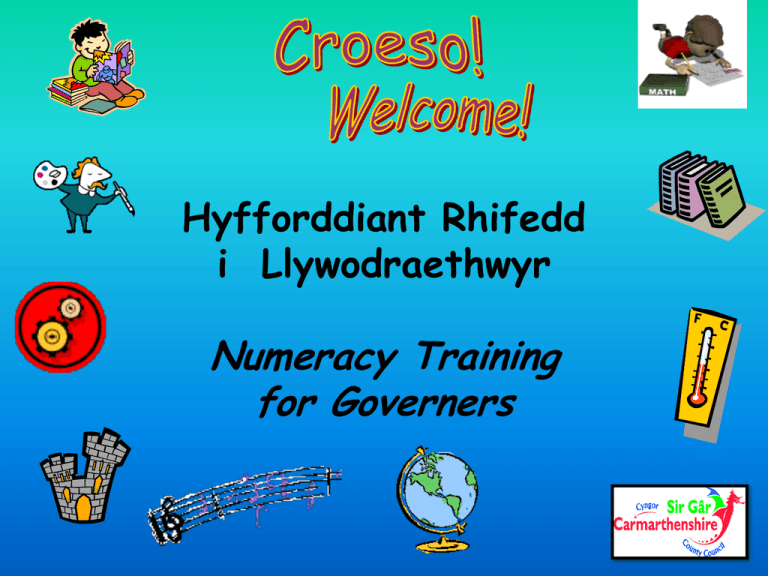
Hyfforddiant Rhifedd i Llywodraethwyr Numeracy Training for Governers 3 more than 5 square root of 64 it is not a multiple of 3, 5 or 2 9 less than 18 it’s not an odd number 8 the total of 3.33 a 4.77 3 plus 3 plus 3 take away 1 one less than 3 squared quarter of 33 Estyn 2010 ‘Numeracy is not the same as mathematics. Numeracy is a proficiency with number that is acquired through being taught mathematics well. Although pupils usually learn their numeracy skills during mathematics lessons, to be fully numerate they must be able to apply these skills in other subject areas and reallife contexts.’ National Numeracy Programme Numeracy refers to the application of mathematical understanding in daily activities at school, at home, at work and in the community. There is more to numeracy than teaching the rules and procedures of mathematics. However, it is imperative that the fundamental mathematical techniques are taught to a standard that allows learners to be numerate. Numeracy describes the set of skills needed to tackle realworld problems in a variety of situations by applying numerical reasoning, and then carrying out the mathematical procedures to find the solution. The Welsh Government’s priority is to raise standards in literacy and numeracy in schools across Wales. The Department for Education and Skills’ Numeracy Branch has developed a National Numeracy Programme (NNP). The NNP is produced bilingually. It sets out the actions that we and our partners will take to achieve a step-change in standards across the curriculum over the next five years. The NNP, aimed at 5 to 14-year-olds, will propose action at national, local and school level to help support learners so that they leave school equipped with the numeracy skills they need. Schools and teachers are expected to: • use the National Literacy and Numeracy Framework (LNF) and available support to plan their curriculum and to monitor learner progress, inform self-evaluation, report to parents/carers and to identify where support for learning is needed • administer the numeracy tests, analyse and use the data at individual learner and group level to outline the next learning steps and to address learning gaps and problems creatively and proactively to raise standards • use the numeracy tests at whole-school level to identify strengths and areas for improvement in learning and teaching • use the numeracy tests to help inform school self-evaluation, development planning and areas of improvement, and identify whole-school resourcing and individual staff CPD needs • encourage and support newly qualified teachers to take The Masters in Educational Practice (MEP) or access the relevant learning materials for CPD purposes • use the teacher CPD resources on the Learning Wales website • be active users of Learning Wales and feed back if there are areas of numeracy support that can be enhanced and developed further • take part in PLCs to develop their own professional skills in numeracy and applying the LNF • seek an opportunity to be, or to learn from, outstanding teachers of numeracy • take up opportunities to gain from CPD support in financial literacy • use consortia guidance and support to identify learners needing catch-up programmes in numeracy, and make use of proven interventions to help those children progress • use opportunities funded by Welsh Government to work with employers in specific actions to raise numeracy standards • work with Foundation Phase materials focusing on early number skills, where applicable. Numeracy visit guidance - introduction • It has been agreed that the second link visit across the region will focus on standards and provision in numeracy. • The visits will consider how well pupils use their numeracy skills across the curriculum and how well prepared schools are for implementing the Numeracy Framework in September 2013. Numeracy visit guidance - rationale Competency in numeracy is integral to effective learning both within mathematics and in subjects across the curriculum. The focus on numeracy is in response to the Minister for Education and Skills’ priority for improving standards of numeracy, and the Welsh Government’s commitment to developing a National Numeracy Programme (NNP) over the next five years. Aim of the reviews to assess how well schools are: • Integrating the teaching of numeracy across the curriculum so that learners can apply numeracy skills across different subject areas • Ready for the implementation of the Numeracy Framework • Using teaching styles and methods which engage and motivate learners and enable them to tackle PISA style questions and questions within GSCE examinations which require the application of numeracy skills; • • Using intervention programmes effectively to support pupils who are falling behind their peers Raising the profile of numeracy Process All schools will have a numeracy review in the Spring or Summer term 2013. In 60% of schools this review will take place as part of the second entitlement visit and will consist of: – A dialogue with the Head teacher/SMT and lead person for numeracy to discuss planning for improvement in numeracy and the impact on standards – A scrutiny of learners’ work across the curriculum – Interviews with learners • All schools will be sent the numeracy audit to use as a self-evaluation tool Process • 40% of schools will have a full review that will consist of: – a dialogue with the Head teacher/SMT and lead person for numeracy to discuss planning for improvement in numeracy and the impact on standards – a scrutiny of pupils’ work across the curriculum – interviews with learners – lesson observations from a range of subjects Our selection of these schools is based on the following principles : Targeting schools to be inspected in the next two years Information from the autumn term visit, mathematics data and school context Ensuring a cross section of schools within the matrix Before a review Local Authority School Analyse school data for mathematics. Note any recommendations from previous Estyn inspections. Consider targets from the autumn term dialogue. Check the school has received the numeracy audit Provide any data or relevant information requested by the CSIO. Complete numeracy audit and return to CSIO Plan and agree on specific timetable for the review with school. Share aim of the review and timetable with all school staff. Organise and brief team Head, member of SMT or curriculum leader are invited to join the LA team. We have also agreed the following regarding the process: Lesson observation will focus on Years 2, 4, 6, 7 a 9 only, and we will look at pupils’ books and discuss with groups of pupils as a natural part of this process – taking groups out of class for a time to discuss with them. Naturally pupils in the above years will be in mixed year classes in smaller schools, but that is something we simply have to accept Numeracy Audit Aims • To promote a common language and process across the six local authorities in the region. • To provide a framework that assists schools to evaluate provision for numeracy Objective To provide a self evaluation tool that can be used by senior managers to promote dialogue and discussion and identify strengths and areas for improvement in the teaching and learning of numeracy. Using the numeracy audit This audit is a tool that has been produced for senior managers to use as part of their self-evaluation process. Statements and prompts are provided to help managers evaluate: how well learners use their numeracy skills across the curriculum; and how well-prepared they are for implementing the National Numeracy Framework when it becomes statutory in September 2013. Estyn guidance and remit reports, and the National Numeracy Programme were used to develop the statements and prompts. The audit should be used: to inform development planning; to inform the dialogue between Headteachers and CSIO’s; as a starting point for those schools having a numeracy review; to identify strengths and areas for development in leadership, learning and teaching. Mental Mathematics Interview The key aims of the Literacy and Numeracy Frameworks are to: • help teachers of all subjects to identify and provide opportunities for learners to apply literacy and numeracy across the curriculum, and is broken down by year group • describe, with precision, the annual national expectations for literacy and numeracy for learners 5– 14, and progression indicators for learners with additional learning needs • help determine learner progress in literacy and numeracy and provide annual reports to parents/carers based on teacher assessment so that teachers, learners and parents/carers are all clear how learners are progressing and what are the next steps. Following consultation the final version of the LNF is now available online for schools to use on a non-statutory basis and on a statutory basis from September 2013. It will be fully supported by a comprehensive range of online guidance and training materials and we will assess the need for further training. NUMICON 0 zero 1 one 2 two 3 three 4 four 5 five 6 six 7 seven 8 eight 9 nine 10 ten 4 8 2 10 1 3 5 9 0 1 2 3 zero one two three 4 5 6 7 four five six seven 5 1 9 10 2 8 five ten nine one two eight Double… 3 Half… 6 1p 2p 5p 10p £1 = Different ways of making 7 Different ways of making 13 Base 10 1 0 9 1 09 19
